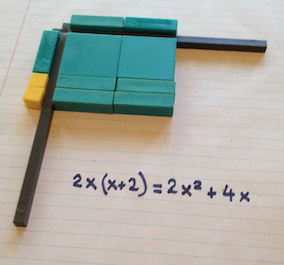Registration is now open for my summer workshops. See the information at the end of this newsletter, and sign up!
This issue of my newsletter focuses on the concept of function, a topic relevant throughout secondary school. Because it is a key to so many ideas and applications, it is important to teach it in multiple ways in order to reach more students, and to yield deeper understanding for all. I have developed a fair amount of curriculum to do just that.
Read all about it below!

Teaching About Functions
Links to curriculum materials on my Web site.
In the 1990's, functions gradually expanded from their traditional place in the curriculum (a precalculus topic) to a much more prominent role in secondary school math, starting in Algebra 1. That evolution has continued, and the Common Core State Standards for Math (CCSSM) include functions as an 8th grade topic, and as its own strand in high school, on an equal footing with Number, Algebra, Geometry, and Probability.
This trend is largely a good thing, because functions are a key concept in modeling and "real world" applications of math, another CCSSM concern. Moreover, functions connect with every other strand, and can enrich the teaching of everything from exponents and equation solving to transformational geometry and two-variable statistics.
In the old days, functions were laboriously graphed by plotting individual points. This is no longer necessary, given the availability of electronic graphers. However, while this technology has mostly been an important and powerful addition to our tool chest, it should not be used as a substitute for students engaging intellectually with the material. Read on for links to some activities in which I have tried to avoid that trap.
Algebra: Themes, Tools, Concepts
- Algebra: Themes, Tools, Concepts (ATTC), the textbook I co-authored with Anita Wah, includes many excellent lessons on functions, mostly but not exclusively linear functions. Here is an index to those lessons:
- Visual/geometric context: 1.1, 1.2, 1.A, 1.7, 1.11 2.10, 2.11, 2.C
- "Real world" context: 3.1, 3.8, 3.C, 4.1, 4.A, 4.6, 4.7, 4.10, 5.1, 5.2, 6.1, 6.A, 9.B, 10.B, 12.1-12.7
- Puzzle context: 3.4, 3.A, 4.8
- Graphing: 4.2, 4.4, 4.5, 4.B, 4.11, 5.A, 6.5, 6.B, 8.3, 8.4, 8.A, 10.5, 10.8
- Linear vs. nonlinear: 4.3, 7.2, 7.A, 8.1, 8.7, 8.8, 8.B, 9.6-9.7
- Exponential functions: 8.5, 8.6
- Square root function: 9.5, 12.B
- Quadratic functions: 5.5, 13.1-13.A, 13.7, 14.4, 14.6
- A general guideline is that chapters 1-8 are suitable for middle school and Algebra 1. Chapters 6-10 should work in Algebra 1. Chapters 10-14 are resolutely aimed at high school.
For material on sequences and series, click here.
If this list is too overwhelming, you can get started by looking at a selection of sample ATTC lessons on this page. If you like what you find there, then definitely check out the above.
One more unit along the same lines, but not from ATTC: Comparing Cell Phone Plans
Electronic Graphing
There are many electronic graphing platforms. In addition to the widely adopted (and standardized-test-legal) graphing calculators, we now also have many options on tablets, on phones, and on the Web. Over the past few decades, I have created many activities for students who have access to electronic graphers. I am in the process of adapting those to new technologies, but you need not wait for the updates, as the activities are mostly usable as they are.
They cover a wide range of functions: linear, quadratic, exponential, logarithmic, square roots, absolute value, and more. The activities cover the full range of middle school and high school math levels, including Algebra 2 and Precalculus. In all of them, I try to maximize reflection, discussion, and learning, and only use the "graph this, graph that" routine minimally and judiciously. The activities are indexed on this page.
In particular, check out the first and last activities on the list. I wrote about the first ("Make These Designs") here, and about the last ("Doctor Dimension") here.
More Functions
For a wide-ranging overview of quadratic functions, covering Algebra 1, Algebra 2, Calculus, and teachers' mathematics, click here.
For two units on iterating functions (linear – appropriate for Algebra 2, and a great intro to sequences; and nonlinear – chaos, suitable for precalculus), click here.
Finally, to learn about the many uses of a parallel axes representation of functions, go to my launch page about function diagrams. There, you will find an overview of this unfamiliar but powerful pedagogical tool, and links to many worksheets and applets.
Summer Workshops
I'll be teaching four workshops this summer, in two new locations: Seattle, WA and Waltham, MA (which is a half-hour West of Boston.) If you've meant to attend my workshops in the past, but couldn't make it to San Francisco, New York, or DC, perhaps these venues are more convenient for you? There will be no workshop in San Francisco this summer, though I hope to have something in the Bay Area in 2016.
The East Coast workshops are intended for middle school teachers, and include much kinesthetic and manipulative work. The West Coast workshops will also include middle school teachers, but the content will range all the way up to 11th grade and beyond, and will include a more substantial tech component.
All the workshops are consistent with the Common Core mathematical practices standards. The content is largely aligned with the Common Core, but it is not limited by it, as I always include some enrichment topics and some in-depth explorations. As always, I will emphasize a tool-rich pedagogy, including plenty of work with manipulatives and technology.
